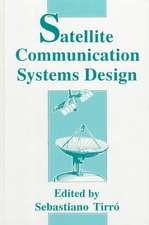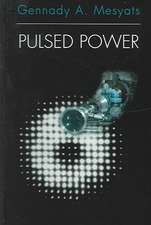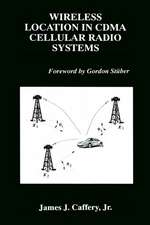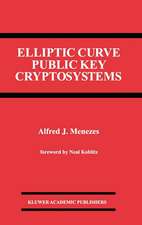Communication System Design Using DSP Algorithms: With Laboratory Experiments for the TMS320C6701 and TMS320C6711: Information Technology: Transmission, Processing and Storage
Autor Steven A. Tretteren Limba Engleză Paperback – 31 ian 2003
| Toate formatele și edițiile | Preț | Express |
|---|---|---|
| Paperback (3) | 343.12 lei 6-8 săpt. | |
| Springer Us – 31 ian 2003 | 343.12 lei 6-8 săpt. | |
| Springer Us – 31 aug 1995 | 393.74 lei 6-8 săpt. | |
| Springer Us – 4 ian 2008 | 401.79 lei 6-8 săpt. |
Din seria Information Technology: Transmission, Processing and Storage
- 15%
 Preț: 633.53 lei
Preț: 633.53 lei - 15%
 Preț: 636.80 lei
Preț: 636.80 lei - 15%
 Preț: 528.63 lei
Preț: 528.63 lei -
 Preț: 389.49 lei
Preț: 389.49 lei - 15%
 Preț: 587.72 lei
Preț: 587.72 lei - 18%
 Preț: 1398.00 lei
Preț: 1398.00 lei - 15%
 Preț: 650.55 lei
Preț: 650.55 lei - 15%
 Preț: 655.78 lei
Preț: 655.78 lei - 15%
 Preț: 649.06 lei
Preț: 649.06 lei -
 Preț: 416.05 lei
Preț: 416.05 lei - 20%
 Preț: 610.31 lei
Preț: 610.31 lei - 18%
 Preț: 955.70 lei
Preț: 955.70 lei - 18%
 Preț: 960.78 lei
Preț: 960.78 lei - 15%
 Preț: 640.88 lei
Preț: 640.88 lei - 18%
 Preț: 1119.08 lei
Preț: 1119.08 lei - 18%
 Preț: 954.31 lei
Preț: 954.31 lei - 20%
 Preț: 346.24 lei
Preț: 346.24 lei - 20%
 Preț: 649.09 lei
Preț: 649.09 lei - 18%
 Preț: 1687.01 lei
Preț: 1687.01 lei - 18%
 Preț: 1686.04 lei
Preț: 1686.04 lei - 18%
 Preț: 1856.54 lei
Preț: 1856.54 lei - 20%
 Preț: 352.54 lei
Preț: 352.54 lei
Preț: 343.12 lei
Preț vechi: 428.89 lei
-20% Nou
Puncte Express: 515
Preț estimativ în valută:
65.65€ • 68.74$ • 54.46£
65.65€ • 68.74$ • 54.46£
Carte tipărită la comandă
Livrare economică 09-23 aprilie
Preluare comenzi: 021 569.72.76
Specificații
ISBN-13: 9780306474293
ISBN-10: 0306474298
Pagini: 301
Ilustrații: XXI, 301 p.
Dimensiuni: 178 x 254 x 26 mm
Greutate: 0.71 kg
Ediția:2003
Editura: Springer Us
Colecția Springer
Seria Information Technology: Transmission, Processing and Storage
Locul publicării:New York, NY, United States
ISBN-10: 0306474298
Pagini: 301
Ilustrații: XXI, 301 p.
Dimensiuni: 178 x 254 x 26 mm
Greutate: 0.71 kg
Ediția:2003
Editura: Springer Us
Colecția Springer
Seria Information Technology: Transmission, Processing and Storage
Locul publicării:New York, NY, United States
Public țintă
GraduateCuprins
Preface.- 1. Overview of the Hardware and Software Tools.- 2. Learning to Use the Hardware and Software Tools.- 3. Digital Filters.- 4. The FFT and Power Spectrum Estimation.- 5. Amplitude Modulation.- 6. DSBSC Amplitude Modulation and Coherent Detection.- 7. Single-Sideband Modulation and Frequency Translation.- 8. Frequency Modulation.- 9. Pseudo-Random Binary Sequences and Data Scramblers.- 10. Introduction to the RS-232C Protocol and a Bit-Error Rate Tester.- 11. Digital Data Transmission by Baseband Pulse Amplitude Modulation.- 12. Variable Phase Interpolation.- 13. Fundamentals of Quadrature Amplitude Modulation.- 14. QAM Receiver I - Clock Recovery and Other Front-End Subsystems.- 15. QAM Receiver II - Equalizer and Carrier Recovery System.- 16. Echo Cancellation for Full-Duplex Modems.- 17. Suggestions for Additional Experiments. A: Generating Gaussian Random Numbers. B: A TTL/RS-232C Interface for Serial Port 1. C: Equipment List for Each Station.- References: I. List of Manuals. II. Selected Reference Books and Papers. III. Interesting Web Sites.- Index.
Textul de pe ultima copertă
Designed for senior electrical engineering students, this textbook explores the theoretical concepts of digital signal processing and communication systems, using practical laboratory experiments with real-time DSP hardware. Originally designed with older Texas Instruments models in mind, this new edition updates the experiments to incorporate the TMS320C6713TM DSK, while remaining relevant for other DSP boards. The C6713TM DSK is now the preferred board in educational DSP labs; this edition stays current with these new changes in the field.
The primary focus of this book is communication systems, including algorithms that are particularly suited to DSP implementation. Software and hardware tools are introduced, as well as FIR and IIR digital filters and the FFT. This book also discusses modulators and demodulators for classical analog modulation methods such as amplitude modulation (AM), double-sideband suppressed-carrier amplitude modulation (DSBSC-AM), single sideband modulation (SSB), and frequency modulation (FM).
The second half of the book explores digital communication methods leading to the implementation of a telephone-line modem. This new edition also incorporates a comprehensive discussion of Orthogonal Frequency Division Multiplexing (OFDM), which is particularly pertinent as the world is heavily turning towards using wireless wideband communication. Methods for adaptive equalization, carrier recovery, and symbol clock tracking are presented as well, with suggestions for additional experiments.
Steven A. Tretter received the BSEE degree from the University of Maryland in 1962 and the PhD degree in Electrical Engineering from Princeton University in 1966. He is currently an Associate Professor in the Department of Electrical and Computer Engineering at the University of Maryland, College Park. His areas of expertise include communication systems, digital signal processing, anderror correcting codes. He has been a consultant to several telephone-line modem manufacturers since 1970. Many of the algorithms presented in this book were developed for and are used in commercial DSP-based modems. He is presently a consultant to a group at Texas Instruments in Germantown, MD, creating optimized DSP code for wireless OFDM systems.
Cover design by Susanne Van Duyne (Trade Design Group)
The primary focus of this book is communication systems, including algorithms that are particularly suited to DSP implementation. Software and hardware tools are introduced, as well as FIR and IIR digital filters and the FFT. This book also discusses modulators and demodulators for classical analog modulation methods such as amplitude modulation (AM), double-sideband suppressed-carrier amplitude modulation (DSBSC-AM), single sideband modulation (SSB), and frequency modulation (FM).
The second half of the book explores digital communication methods leading to the implementation of a telephone-line modem. This new edition also incorporates a comprehensive discussion of Orthogonal Frequency Division Multiplexing (OFDM), which is particularly pertinent as the world is heavily turning towards using wireless wideband communication. Methods for adaptive equalization, carrier recovery, and symbol clock tracking are presented as well, with suggestions for additional experiments.
Steven A. Tretter received the BSEE degree from the University of Maryland in 1962 and the PhD degree in Electrical Engineering from Princeton University in 1966. He is currently an Associate Professor in the Department of Electrical and Computer Engineering at the University of Maryland, College Park. His areas of expertise include communication systems, digital signal processing, anderror correcting codes. He has been a consultant to several telephone-line modem manufacturers since 1970. Many of the algorithms presented in this book were developed for and are used in commercial DSP-based modems. He is presently a consultant to a group at Texas Instruments in Germantown, MD, creating optimized DSP code for wireless OFDM systems.
Cover design by Susanne Van Duyne (Trade Design Group)
Caracteristici
Completely updated for TM13S320C6 DSK board New chapter on OFDM Third edition of popular textbook























